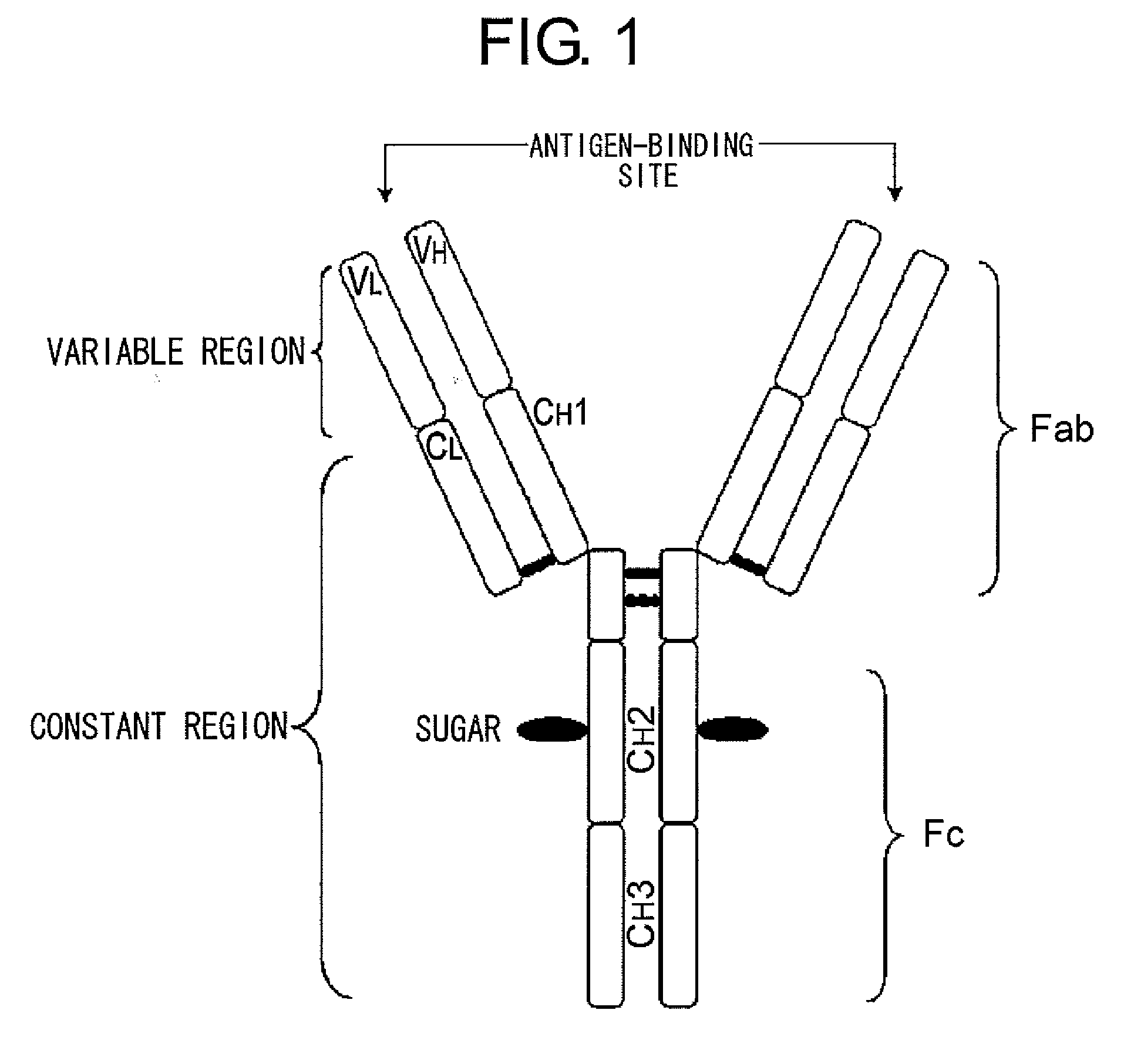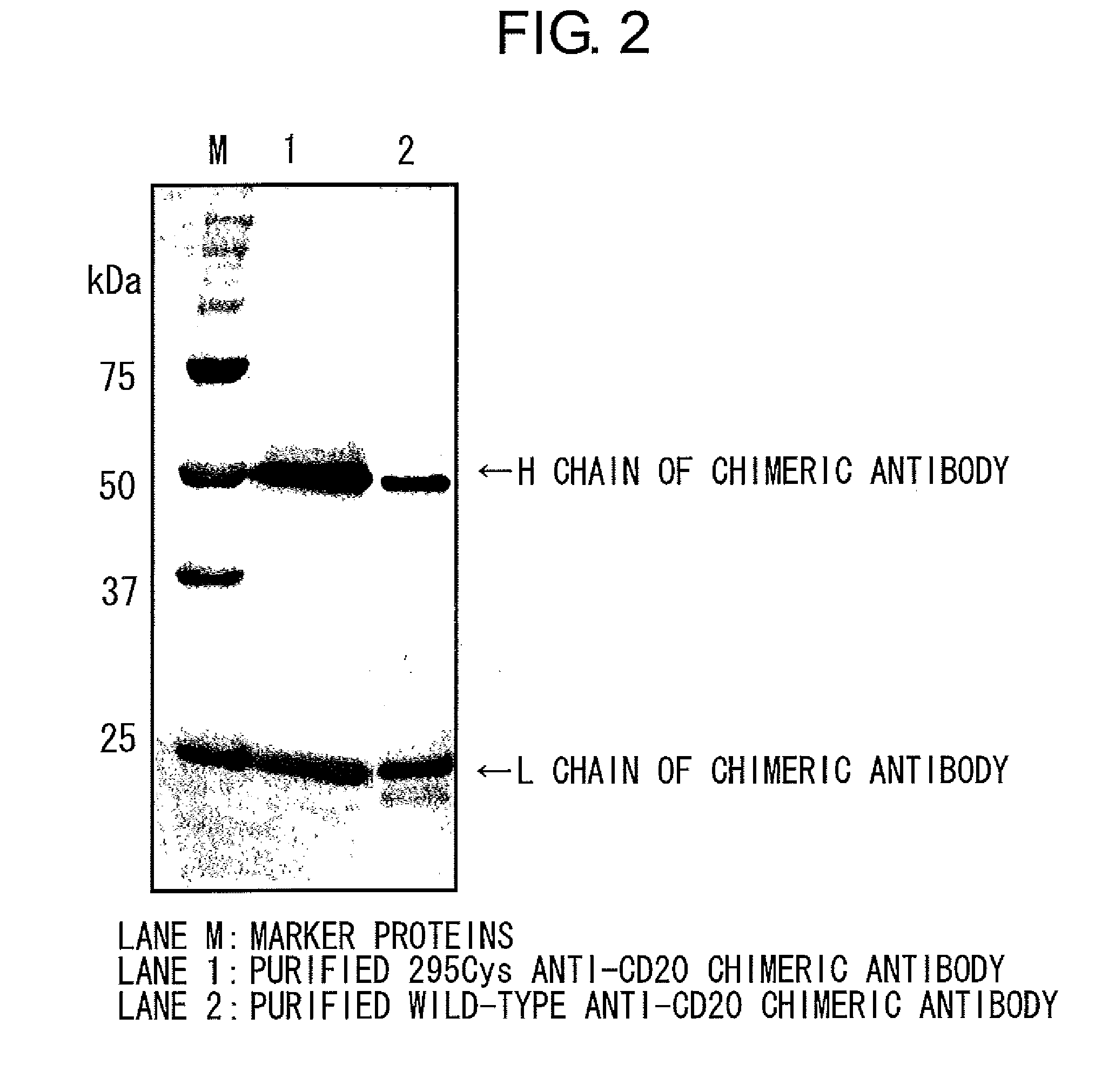Mutant polypeptide having effector function
a technology of effector function and polypeptide, which is applied in the field of mutation polypeptides containing an fc region, can solve the problems of increasing the cost of antibody production, and achieve the effects of strong pharmacological activity, enhanced effector function, and few side effects
- Summary
- Abstract
- Description
- Claims
- Application Information
AI Technical Summary
Benefits of technology
Problems solved by technology
Method used
Image
Examples
preparation example 1
Isolation and Purification of Human Peripheral Blood Mononuclear Cells
[0175]Human blood was collected into a blood collecting bag (TERUMO CORP.) containing anticoagulant. This blood was laid onto a Lymphoprep solution (AXIS-SHIELD), which was dispensed into 50 ml centrifuge tubes (Falcon) in 15 ml-aliquots, and then centrifuged in a conventional swing-type centrifuge for cell isolation at 1,600 rotations for 30 minutes at room temperature according to the manufacturer's instructions. Following centrifugation, the mononuclear cell layer was collected, washed three times with calcium and magnesium free phosphate buffered saline supplemented with bovine serum albumin (BSA, Sigma) at a final concentration of 0.5% (w / v) (BSA-PBS, Sigma), and dispersed into RPMI-1640 medium containing fetal calf serum (FCS) at a final concentration of 10% (10% FCS-RPMI-1640), according to the manufacturer's instructions. This solution was used in the following examples as the cell suspension of mononuclea...
example 1
Humanized Anti-CD20 Chimeric Antibody and Humanized Anti-CD20 Chimeric Antibody Cys Mutant
1. Preparation of Humanized Anti-CD20 Chimeric Antibody Expression Vectors:
[0176]1-1. Construction of cDNA Encoding the L Chain V Region of Mouse Anti-CD20 Monoclonal Antibody:
[0177]A cDNA encoding the amino acid sequence of the light chain variable region (hereinafter, referred to as “VL”) of the mouse anti-CD20 monoclonal antibody, 2B8, described in WO 94 / 11026 was constructed using the PCR method described below.
[0178]First, to facilitate cloning into an expression vector, restriction enzyme recognition sequences were added to 5′ and 3′ ends of the cDNA sequence of the VL described in WO94 / 11026, the sequence at 5′-end being restriction enzyme Sac I sequence and the sequence at 3′-end being restriction enzyme Hind III sequence. The designed nucleotide sequence was then divided into six nucleotide segments of about 100 bases, starting from the 5′ end and with adjacent nucleotide sequences hav...
example 2
Preparation of Anti-CD20 Chimeric Antibodies
1) Preparation of Anti-CD20 Chimeric Antibodies:
[0188]Chimeric antibodies were obtained as purified chimeric antibodies through the following steps A to F:
A) cloning of genes required for the preparation of chimeric antibodies;
B) mutagenesis of a cloned gene;
C) construction of chimeric antibody-expression vectors into which a cloned gene or its mutated gene is combined;
D) gene introduction into CHO cells with the chimeric antibody-expression vectors;
E) culture of chimeric antibody-expressing CHO cells; and
F) column purification from culture supernatant of the chimeric antibody-expressing cells.
[0189]Steps A to F are described in further detail below.
A) Cloning of Genes Required for the Preparation of Chimeric Antibodies:
[0190]Four kinds of genes are required for the preparation of a single kind of anti-CD20 chimeric antibody. The four kinds of genes are a mouse anti-CD20 L chain variable region gene, a mouse anti-CD20H chain variable regio...
PUM
| Property | Measurement | Unit |
|---|---|---|
| temperature | aaaaa | aaaaa |
| pH | aaaaa | aaaaa |
| pH | aaaaa | aaaaa |
Abstract
Description
Claims
Application Information
 Login to View More
Login to View More - R&D
- Intellectual Property
- Life Sciences
- Materials
- Tech Scout
- Unparalleled Data Quality
- Higher Quality Content
- 60% Fewer Hallucinations
Browse by: Latest US Patents, China's latest patents, Technical Efficacy Thesaurus, Application Domain, Technology Topic, Popular Technical Reports.
© 2025 PatSnap. All rights reserved.Legal|Privacy policy|Modern Slavery Act Transparency Statement|Sitemap|About US| Contact US: help@patsnap.com



